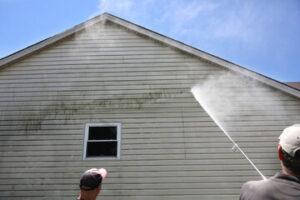Power washing is a quick, efficient way to clean your property. It’s also a useful tool for home maintenance and can increase curb appeal if you’re planning to sell your house.

Power washing uses hot, pressurized water to cleanse surfaces outside your home or commercial business. The heat breaks up dirt, grime, mildew and grease, making it easier to remove. Keep reading the article below to learn more about Power Washing Services.
Power washing uses pressurized heated water to cleanse soiled, stained and moldy surfaces. It helps to remove pollutants and contaminants from the surface without causing damage to materials like vinyl, aluminum, wood, and paint. It also helps to prolong the life of these surfaces and enhances curb appeal and value. This type of cleaning is an excellent method for removing dirt, grime, mildew, moss, and lichen from surfaces on homes, apartments, condominiums, restaurants, retail stores, warehouses, office buildings, parking garages, and other commercial properties.
It is recommended that home owners should schedule exterior cleaning services once or twice a year. This is a cost-effective way to keep your property in good condition and can help extend the lifespan of your siding, brick, hardy plank, or whatever material your house is constructed from.
In addition, regular power-washing can help reduce the risk of costly repairs or replacements. Mildew, mold and algae can damage your home’s exterior and interior surfaces if left unattended. Power-washing removes these contaminants and prevents them from settling into the cracks and crevices of your home, which can lead to rot and other damage.
If your property is surrounded by trees, bushes, and other plants, it is important to monitor them for sap buildup. This type of residue can create stains on your home’s windows, door frames, and shutters. It can also promote the growth of fungus and other plant life, reducing your home’s curb appeal and value.
To avoid this, hire a professional who offers power-washing services for these types of trees and plants. They can also offer other landscaping and outdoor cleaning services.
It is important to examine your property and determine how often you should have it power-washed. Some factors to consider include your location, the amount of rain and wind, and other environmental factors. One easy way to test if your siding or brick needs to be washed is to run your finger along the surface. If you feel grit on your finger, it is time to call the power wash contractors.
When choosing a contractor for power washing, make sure to find out how many similar properties they have cleaned and ask about their experience. It is also helpful to find out what type of products they use for different surfaces and whether or not they are environmentally friendly.
Roof Cleaning
Roofs are one of the most important features that protect a home from harsh outdoor elements. Their durable construction and materials allow them to withstand many types of weather, but they still need regular cleaning in order to maintain their integrity. This includes the removal of moss, mildew, fungus and other organic growth that can weaken shingles and lead to leaks inside the house. Cleaning contractors can use a power washing system to clean the entire roof surface without damaging the shingles. They also have experience in working safely with power equipment and are familiar with the best methods for completing roof cleaning services.
Roof cleaning should be done on a regular basis to prevent moisture damage and keep the home’s interior safe from mold, mildew, fungus, lichen, and other organic growth. These contaminants can cling to roof shingles and troughs, creating areas where water can pool and leak into the home. Cleaning services can remove these contaminant accumulations, as well as tarps and other roof coverings.
Power washing can make a home’s exterior look new and improve its curb appeal. It can also reveal areas where repairs are needed, such as cracks in brick and siding or tears in aluminum siding. This information can help a homeowner plan for these repairs and ensure that the structure of the home is protected from further damage.
Cleaning a home’s exterior surfaces, including the roof, can help maintain a home’s value and prolong its lifespan. Regular cleaning can also help prevent problems such as ice dams, which form when snow and ice build up under and around roof shingles.
When hiring a power washing company to perform exterior cleaning, homeowners should be sure that the contractor is licensed and insured. In addition, they should prepare for the work by securing ladders and removing any loose debris. It is also important to follow all safety guidelines when using a power washer, such as wearing appropriate clothing and using protective goggles. It is also recommended to hire a professional that offers soft washing for roofs and other delicate surfaces, such as clay roofing tiles.
Deck Cleaning
When you invite friends and family over to enjoy your home, a clean deck elevates the appearance of the gathering and helps your guests feel more welcome in your home. Power washing the deck and other outdoor areas of your home is an effective way to get rid of the dirt, grime, mold, mildew, and algae buildup that can make your outdoor living spaces look dull and unkempt.
If you choose to use a power washer, it is important that you have the right knowledge to operate it correctly and safely. Power washers can damage wood, stone, vinyl siding, and other materials on your home if used incorrectly.
A professional power wash service will be able to help you determine the best cleaning method for your home and use the right tools to ensure that the job is done effectively and safely. For instance, they will know that it is crucial to avoid putting pressure on the siding of your home as this can cause serious structural damage. They will also use a nozzle that provides a wide spray pattern so that the force of the water does not concentrate on one area and cause damage.
It is important that you hire a professional company to power wash your home and other outdoor areas of your property. These professionals have the experience and the specialized equipment needed to ensure that the job is completed properly and safely. A reputable power washing service will also be licensed and insured, which means that they can offer you a warranty on their work.
When selecting a power washing service, it is important to find out how many years the company has been in business and what type of work they specialize in. You should also ask the potential contractor what types of cleaning products they will use and why. In addition, it is a good idea to find out how often they recommend that your home be cleaned and if they offer a warranty on their work.
Investing in a deck installation is an excellent way to elevate your outdoor living space and create a comfortable area to entertain family and guests. However, even though most modern deck materials are marketed as low maintenance, it is still essential that you regularly clean it to eliminate dust and dirt build up. In addition, a dirty deck will be unable to hold stain or paint well as the material can not penetrate through the surface.
Patio Cleaning
Power washing a concrete patio is an excellent way to refresh outdoor surfaces and improve the appearance of your property. However, it is important to use the right equipment and follow proper safety protocols to avoid surface damage and personal injury. Professional cleaning services like HomeSmiles are available to assist with a wide range of Preventative Maintenance tasks, including power washing your residential or commercial outdoor spaces.
A clean, well-maintained patio is essential for outdoor gatherings and entertaining guests. Over time, your patio can accumulate dirt, mildew, and stains that detract from its aesthetic appeal and cause long-term damage. Power washing is a fast, effective way to remove stubborn grime and prevent future accumulation, making it an ideal solution for residential and commercial properties.
Attempting to power wash your patio without the proper tools and knowledge can result in surface damage, personal injury, and costly repairs. Household patio cleaners and a garden hose can be effective for light cleaning, but they are unable to tackle deep stains or embedded debris. Professional power washing equipment uses a higher pressure and temperature to effectively remove contaminants without damaging your outdoor surfaces. In addition, specialized nozzle attachments allow professionals to select the appropriate level of pressure for specific cleaning jobs.
The process of power washing your patio begins with a thorough inspection and determining the most appropriate method for your surface type. For example, if your concrete is heavily stained, it may be necessary to apply a special concrete cleaner that loosens and breaks down grease, oil, and other materials. For a more eco-friendly option, a vinegar or baking soda solution can be used to pre-treat the concrete. This solution should be allowed to soak for 10-15 minutes before rinsing off with a garden hose.
In addition to providing a fresh, attractive look, regular concrete patio cleaning helps maintain the value of your property and ensures that it is safe for your family, friends, and customers or tenants. Additionally, cleaning services like this can help prevent mold and mildew from growing on your property, reducing health risks associated with exposure to these allergens.
